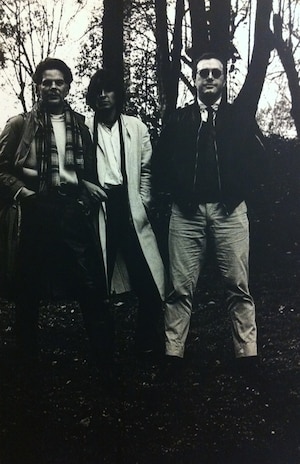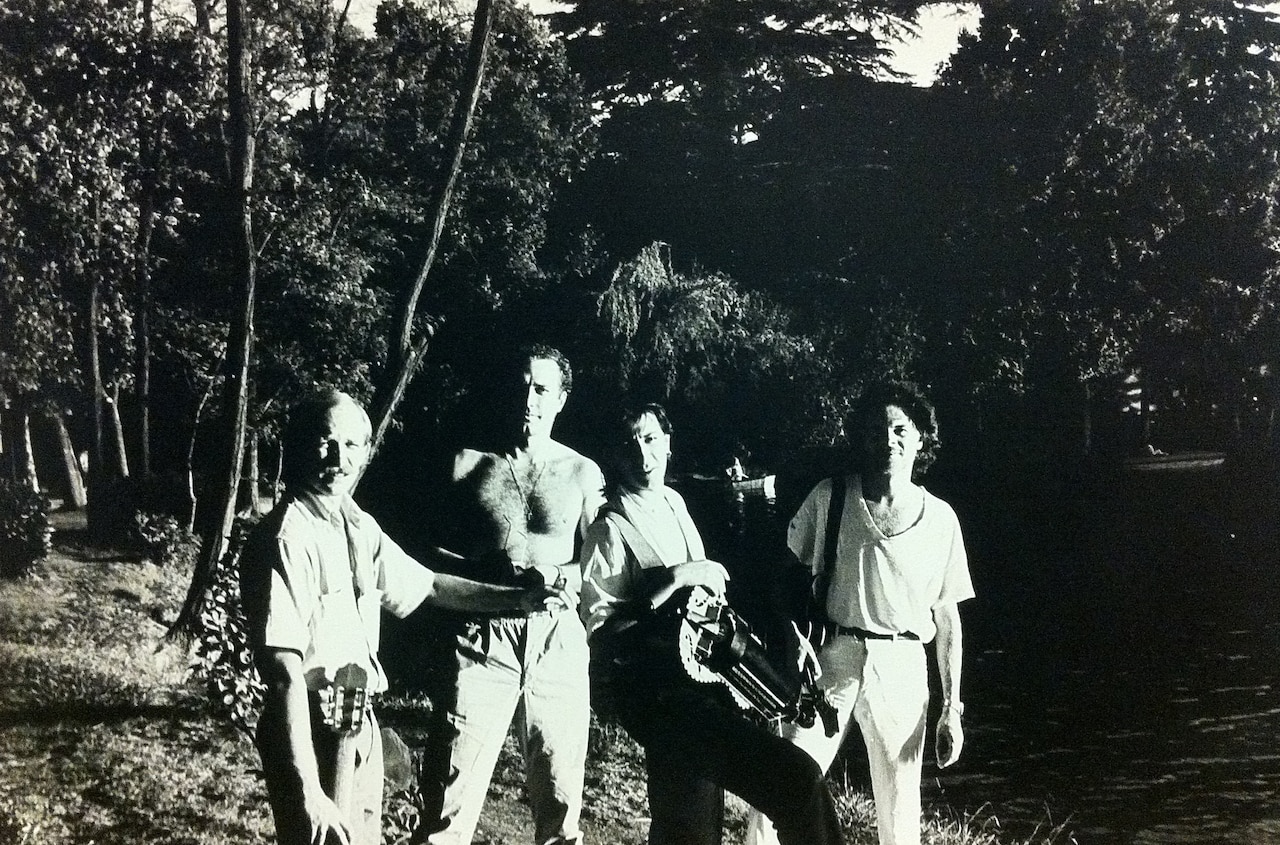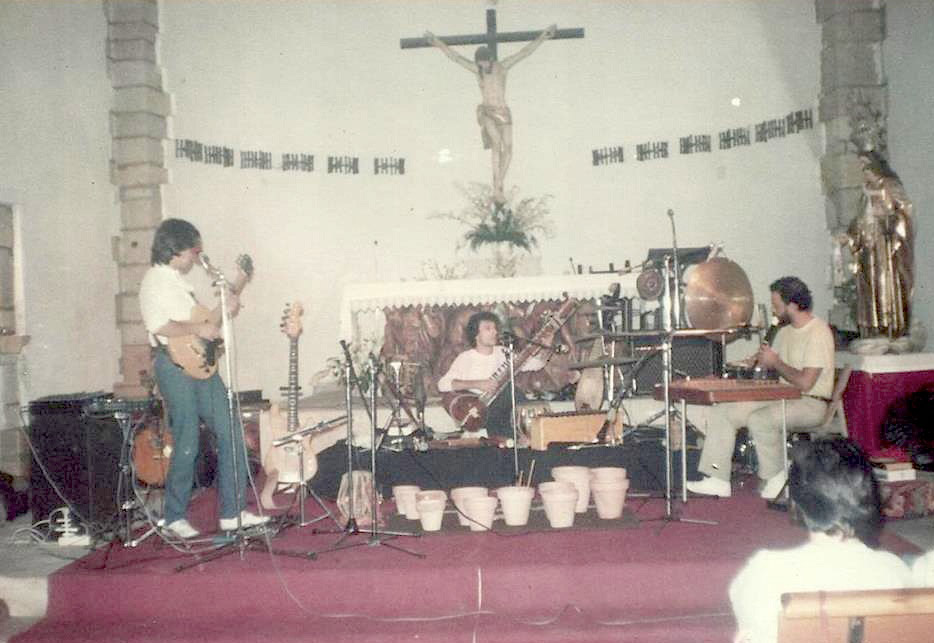The radical sound of Finis Africae
Andy Thomas goes inside the avant-garde, ambient scene of ’80s Spain

By the mid ‘80s Juan Alberto Arteche had tired of conventional music after 15 years with the Spanish folk rock band Nuestro Pequeño Mundo. It was an auspicious moment. The dictator Francisco Franco had died nearly a decade earlier, and the country’s creative class had awoken. “I was in the mood to experiment with other ways to compose and play music,” said Arteche in the sleeve notes to the EM Records compilation Finis Africae - A Last Discovery.
With his friends Javier Bergia and Luis Delgado, Arteche formed the group Finis Africae during Madrid’s post Franco cultural renaissance. Taking their name from a secret room of forbidden books in Umberto Eco's novel The Name of the Rose, the trio’s first two LPs, Prima Travesia and Un Dia En El Parque, were part of a new wave of experimental music released in Spain. Creating collages of avant-garde ambience using instruments from the many corners of the earth, along with tape loops and samples, Finis Africae created a fourth world sound that was both exotic and mysterious.
The artistic movement was known as La Movida Madrileña, and it swept away the rigid set of social structures and control over expression created by Franco’s former regime. “Madrid needed to release its street energy and the proper circumstances came with Enrique Tierno Galvan, a mayor that let citizens and artists express themselves in an environment of freedom that the city had never seen before,” remembers Javier Bergia. While they were liberated by the same freedoms as their contemporaries, however, the members of Finis Africae felt little in common with the sonic direction of La Movida. “The music itself in that scene wasn’t very impressive,” says Bergia.

Indeed, Bergia’s musical origins could hardly be more different to the pop culture aesthetic of La Movida. He was a master of classical guitar, studying with Gregorio Paniagua in the 1970s. Paniagua had formed the Atrium Musicae De Madrid in 1964, spearheading a re-appreciation of ancient European music. “I joined Atrium Musicae almost accidentally in the late ’70s and the experience left a deep mark on me,” says Bergia. “It was my first important musical experience, undoubtedly; the foundation of my entire musical knowledge, and Gregorio Paniagua was one of my best and most important teachers.” Bergia joined the ensemble as they continued to explore the hidden history of ancient Spanish music.
Gregorio Paniagua blew all our minds because he showed us the early music from the inside.
Future Finis Africae member Luis Delgado’s own interest in Spanish early music began as a 14-year-old playing in Orchestra Gaspar Sanz. “Because of the hippie movement in Spain, many of us liked Indian music, but then we also had this interest in Arabic music because it was part of our past,” he says. “Then when I was 19 I met Gregorio and joined with Atrium Musicae (in the mid-‘70s). Gregorio blew all our minds because he showed us the early music from the inside. Not just the historical practice, but also the joy of life in the music. Being with the group was a very intense experience.”
By 1978 Delgado had also started working at RCA Studios in Madrid. “I began as an assistant and then became an engineer and producer,” he says. “This was like a magical dream for me. I would spend 12 or 16 hours a day in the best studio in Spain with the best machines. That access to technology was very important to me. As was working with all kinds of music from classical to flamenco to jazz. When they closed the official studios we would stay behind and do our own interesting experiments.”

Along the way, Delgado met Eugenio Muñoz with whom he founded Mecánica Popular, one of many industrial electronic groups to emerge from Spain during the early ’80s. “I was interested in electronic music since I was 14 when a friend at school made a theremin for me and I began to experiment... With Mecánica Popular we began to work with this strange and experimental music with any equipment we had at hand. We didn’t want to work with instruments we wanted to work with artificially generated, random, sounds.”
The idea was to start a fusion band close to folk timbres and with no boundaries, no “finis,” taking Africa and the Mediterranean in general as the starting point.
Another important collaborator was Javier Bergia, who Delgado had met just prior to joining Atrium Musicae. “It was a crucial time for music in Madrid, where a bunch of musicians were looking for new forms of expression, ways of experimenting and gathering our knowledge,” explains Bergia. One of these musicians was Juan Alberto Arteche. By the early ‘80s he had been part of Nuestro Pequeño Mundo for more than a decade. The group was popular, but he wasn’t entirely fulfilled. “Juan Alberto was a big reference point in Madrid back then,” says Bergia. “We met by chance at some jam sessions, which were very frequent in those days.”
In 1982, Arteche appeared alongside Luis Delgado on Oriente, an LP of space age folk by the group Babia, whose other co-founder was Luis Paniagua, brother of Gregorio. The experience seemed to provide just the inspiration Arteche needed. With a reel-to-reel recorder he had recently acquired, various synthesisers, drum machines, and a range of musical instruments from across the world, Arteche began to experiment. “It was fun to invent new landscapes by recording news from TV or radio, children playing in the court of my house and the noise of the maid when she cleaned at home,” he explained. “I [also] improvised with many of the instruments that were in my room; guitars, autoharps, dulcimers, mandolins, flute.”
After a few months creating experimental soundscapes he decided to share the results. “One day Javier Bergia came over and listened to what I was doing,” he explained. “He was really impressed and he suggested we work together to give free rein to our imaginations.”
After a few weeks of recording, Javier and Juan Alberto shared the results with Luis Delgado. “The idea was to start a fusion band close to folk timbres and with no boundaries, no ‘finis,’ taking Africa as the starting point. Africa and the Mediterranean in general,” says Bergia. “[It] was basically a fusion of folk with Mediterranean, African and Eastern tones, using traditional instruments and applying technology that was barely starting then but seemed very inspiring.”
There would be so many instruments from all over the world, some we didn’t even know how to tune.
What made the group stand apart from its contemporaries was the mix of the electronic and organic. “It was fundamental. That combination was the very essence of the band,” says Bergia. As well as playing guitar, like Arteche he brought to the band his mastery of a vast array of instruments such as the oud, darbouka, tabla and tar drum. “There would be so many instruments from all over the world, some we didn’t even know how to tune, but we got into them anyway,” says Delgado.
The trio embraced electronic recording equipment at exactly the moment it was becoming affordable and portable. “All of us had these Tascam four-track cassette recorders,” explains Delgado. “And this allowed us to make all kinds of experiments in a free way. Before that you either had to have a very expensive machine or go to a professional recording studio. So the arrival of this new technology let us do whatever we wanted. Then very soon the Fostex eight-track reel to reel appeared and all of us got into it very quickly... It was like every month there would be a new device that led you to a new kind of music.”
After a month, they had the music for their first LP and Luis Delgado brought in his old friend Eugenio Muñoz to help as engineer. “In the last part of the process I always insisted we made the mix in a professional studio,” he says. “So you do the takes at home when you have all the time you need, then you get the professional master in the studio.” The album, Prima Travesia, was released on the Grabaciones Accidentales imprint. Set up by producer Paco Trinidad and members of the band Esclarecidos, it was one of many independent labels that sprung up during La Movida. It would become the group’s most sought after LP, as it included “El Secreto de las 12” a Balearic sunset favourite of Café Del Mar DJ José Padilla.
Just as hard to find is the group’s second LP Un Dia En El Parque. The LP was inspired by Arteche’s walks in the Parque del Retiro in Madrid. “I had spent many years walking under the statues, playing football and ‘rescuing’ or falling in love with pretty girls,” he explains. Tracks like “Los Colores de mis Botas,” with its child choir, are evocative of such simple wonders. A more organic offering than the first LP, Un Dia En El Parque also included ambient gems like “Segundos, Segundos, Segundos” and “Triciclos En La Chopera.” The latter was a platform for the beautiful acoustic guitar work of Bergia.
At the same time Un Dia En El Parque was being recorded, Bergia was working on his debut solo LP at the EMI Studios in Madrid. The many collaborators on the 1985 LP Recoletos included Luis Delgado and his old mentor Gregorio Paniagua The LP’s finest moment is “Eucaliptus Blues,” a firm favourite of DJs like Moonboots and José Padilla. Another fan was Stuart Leath, owner of the Emotional Rescue label, who included the track on last year’s Javier Bergia compilation Eclipse.
Eclipse also includes cuts from Bergia’s second LP Tagomago. The album saw Bergia crafting a distinct sound that veered from ambient to soft rock to Spanish classical. Produced by Luis Delgado, it featured his Finis Africae cohort playing bendhir (North African drum), tin whistle, keyboards and percussion.
Tagomago wasn’t the only time Bergia and Delgado collaborated after their work with Finis Africae. Released in 1986, Ishinohana’s La Flor De Piedra found the pair working with guitarist Manuel Illán. The LP has now been re-issued by Emotional Rescue, and it remains close to their hearts. “The idea was to have a very clean sound, very transparent,” explains Delgado. “And even now I’m surprised by the sound we created with just two guitars and a tabla.”
La Flor De Piedra was the first LP to come out on Delgado’s El Cometa de Madrid imprint, a New Age/ambient sub label of Grabaciones Accidentales. “At that time I needed a label that was open to releasing our records, but this kind of label did not exist in Spain at the time,” says Delgado. “We didn’t have anything like ECM or Windham Hill… We released two or three records a year, with close friends and other session musicians who hadn’t released records in their own name until then.” El Cometa De Madrid was home to LPs by Luis Paniagua and Miguel Herrero. Similar work was also emerging at the same time from Suso Saiz, founder of Orquesta De Las Nubes, and a key figure in Spain’s New Age scene.
The second release on the label was Delgado’s own Vathek. Sub-titled “Procesos Electrónicos Para Instrumentos Acústicos,” the LP took the organic electronic experimentations of Finis Africae into a far more avant-garde corner. “It’s a very strange album. Everything comes through the idea that we have all these machines but we don’t use them 100%,” says Delgado. “For example, for me it wasn’t enough to use a delay as just an effect on a voice or song. I wanted to work deeper with these processors.”
As for Finis Africae, Juan Alberto Arteche returned in 1990 with the LP Amazonia. The album’s masterpiece was “Suite Amazónica,” a glorious piece of South American tinged avant-folk. Finis Africae’s most exotic LP, it also included the rainforest jazz of “Dança Do Corpo.” “[It] illuminated images of some Amazonian Indians in a canoe one of the large rivers that run through the lungs of the Earth,” explained Arteche. The track “Hassell el oso Hormiguero” (Hassell the Anteater) was an oblique tribute to another of the band’s influences, Jon Hassell. Five years later Arteche released the final Finis Africae LP, Campos De Sol Y Luna. It’s his most commercially orientated LP, but well worth seeking out for the lesser-known track “El Baile de Sara.”
More than 30 years since they found a common bond in combining ancient and future music, all three members continue to explore music without borders. As Delgado puts it, “For me, music is one – whether it’s Sephardic music or techno.”
